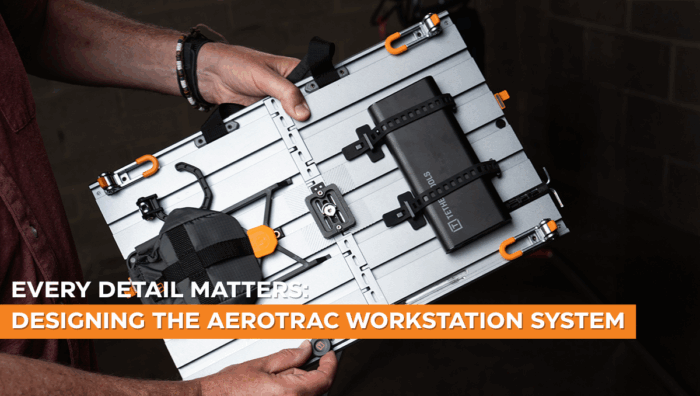
Fifteen years ago, Tether Tools introduced the Tether Table Aero—a simple aluminum surface that mounted to tripods or stands and gave photographers a place for their laptop. It solved a problem, fast.
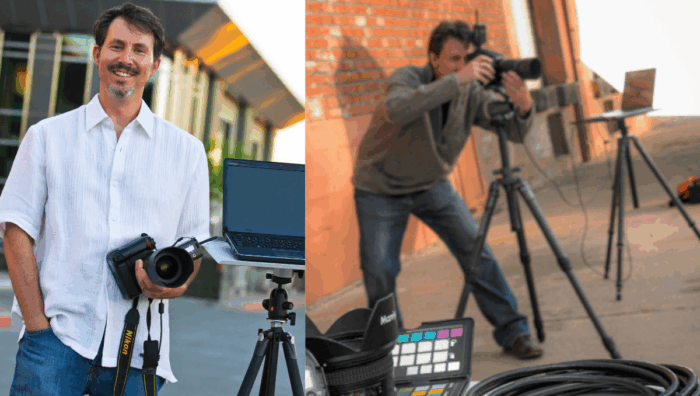
Over time, accessories like the now-iconic retractable cup holder were added, and the Aero became a trusted tool in countless studios and on countless sets. But it wasn’t built as a cohesive system.
Today, the creative landscape looks very different. Photographers and digital techs are constantly on the move. They carry smaller, lighter gear, but more of it, and all of it needs to stay connected. Laptops, portable power, storage, transmitters, monitors, and cables all compete for space in an efficient workflow.
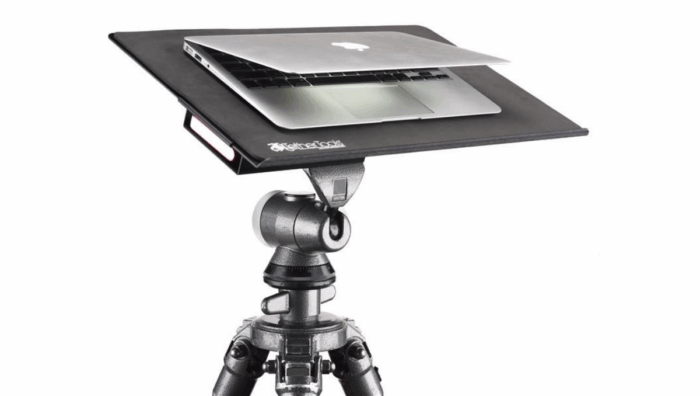
Feedback we’ve heard in recent years confirmed what the team was already seeing: every option in the industry had shortcomings, including the original Aero design. Tables were too heavy, too bulky, and too inconvenient to carry from one location to the next. The problems were pervasive, and just as we did with the original Tether Table fifteen years ago—the Tether Tools product team set out to solve them.
The result is the AeroTrac Workstation System, which is a foldable, portable, and configurable professional-grade platform built from the ground up with custom parts and accessories designed to keep pace with the modern creator.

A Couple of Tethered Workstation Industry Firsts
Like all Tether Tools solutions, AeroTrac followed an intentional development process. Every detail was guided by the same principle that has shaped our cables, cable management, and other workflow accessories: build it to function the way a photographer would actually use it. That’s why TetherPro Optima 10G cables remove power delivery for the most reliable image transfer possible. It’s why our LeverLock cable management solution was engineered so the quick release is just that—quick. The goal has always been to make solutions that are intuitive and earn their place in your kit.
So the product team zeroed in on two big questions.
- First: How do you make a workstation compact enough to take everywhere, but strong enough to support the full setup creators rely on every day? Our answer was to make it foldable.
Compact and Foldable
Folding sounds simple until you try to engineer it into a professional workstation. The table had to support 30 pounds of gear without flexing, stay flat when open, and conveniently fold cleanly in half. The first prototype with push-button locks on either end failed immediately. It wobbled, weighed too much, and didn’t inspire confidence.
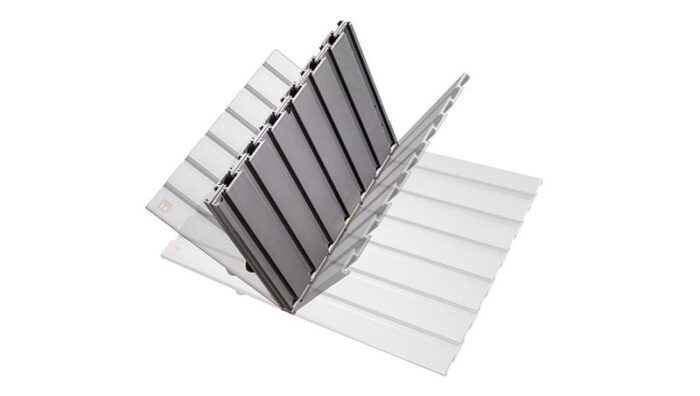
Several design options were explored, and Iteration after iteration followed before the team finalized the spine and locking bar system that defines AeroTrac today. This mechanism allows the surface to fold perfectly flat, keeps the table rigid when open, and lets accessories stay attached on the bottom when packed up. Nobody wants to rebuild their workstation every time they move to a new set or work area, and that small but intentional choice makes AeroTrac not just portable, but truly usable.
Unique Track System
While foldability solved portability, the second breakthrough, the integrated track system, made the workstation endlessly configurable.
Early explorations considered die-cut plates or injection-molded plastics with screw inserts. Each had limitations with less durability, less range of motion, or a less professional feel.

The aluminum track changed everything. It gave creators freedom to slide and lock accessories in the exact place they wanted, top or bottom. It also helps disperse the heat that builds under laptops and hard drives.
And then came the happy accident. By making the track just slightly wider, it could also accommodate a standard cold shoe. That single adjustment opened AeroTrac far beyond its own accessories, making it instantly compatible with the gear creators already carry, like microphones, tablet mounts, and so much more.
Utility You Love to Use
Making AeroTrac fold and the flexibility of the track was one thing. Making it a workstation that photographers would actually love to use was another.

We obsess over function. A tool must solve the problem before anything else. But form isn’t optional—it’s also vital. Creators don’t just need something that works. They need something that looks professional when they walk on set, feels good in their hands, and makes their clients think, this team came prepared.
That’s why the design process kept circling back to small but meaningful details. The weight was cut down as much as possible without losing strength. The edges of the table were beveled and polished to make the table feel finished. An integrated hex wrench tucked into the track saves minutes of fumbling on set.
Over time, each decision made AeroTrac not just useful, but delightful. A workstation you’re proud to put in front of a client.
A Foundation For Endless Configuration
From the very beginning, AeroTrac was never intended to be a standalone table. It was built as a platform. Alongside the core workstation, nearly a dozen core and optional accessories are launching at once—each designed to extend what the table can do. With more already in development, the system will only continue to expand.
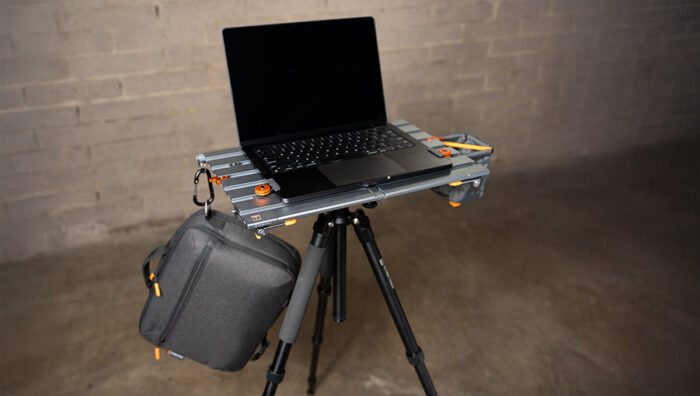
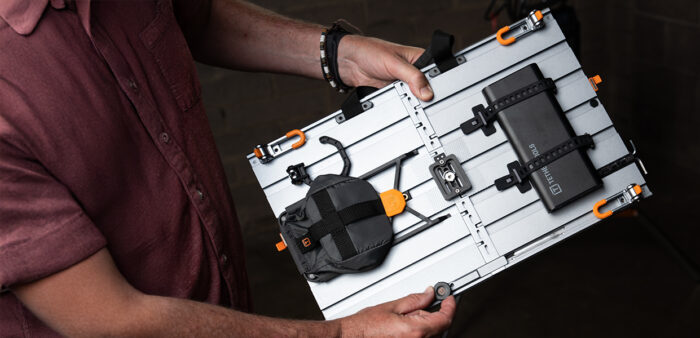


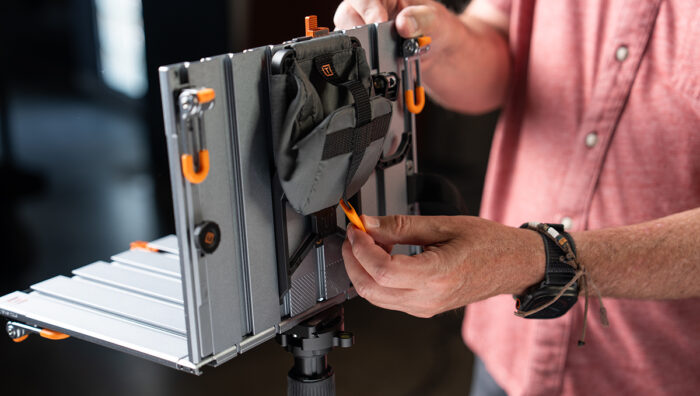
A few favorites from the design process:
- Retractable Accessory Holder. A callback to the original Aero Table, this updated version tucks neatly away when not in use and pops out to provide that signature surprise-and-delight moment.
- Pop-Out Workstation Legs. This optional accessory stays attached so they are never misplaced. The legs fold flat when stored and deploy quickly to let AeroTrac stand on its own without a tripod or stand. You can also unfold just the back legs to create an ergonomic, angled workspace.
- VersaMounts. Secured in each corner, VersaMounts, with integrated VersaGrooves and threads, provide a secure, critical connection point for accessories now and in the future. They’re also a clever way to fasten gear, such as the Aero Sunshade, turning AeroTrac into a reliable outdoor workstation.
- Action Tabs. Originally conceived to easily open and hold the table closed when folded, Action Tabs were upgraded with threads, making them versatile mounting points. At a recent shoot, one was used to hold an iPad under the table facing the subject during seated portraits—a simple hack that instantly expanded the workstation’s role in the creative workflow so the photographer and the subject could see results in real time.
- Co-Creators Welcome. No one will iterate on AeroTrac’s possibilities like photographers themselves. For the makers in our community, we’ve made 3D print files available so you can create your own custom accessories, test new ideas, and share them back with the community. It’s a way to keep AeroTrac evolving beyond what we imagined, shaped directly by the people who use it most.
Built for Creators, Built for What’s Next
The final test isn’t in the Tether Tools design room. It’s in the hands of creators. It’s exciting for our team to see AeroTrac evolve into uses we hadn’t imagined.
Photographers are problem-solvers by nature. They’ll mount gear in unconventional ways, print their own add-ons, and configure AeroTrac to fit workflows no one else has tried. That’s exactly the point. AeroTrac was designed to adapt, not dictate.
For the team, the reward is hearing a simple phrase: this makes my life easier.
Ultra-light. Compact. Versatile. The AeroTrac Workstation System proves that the best tools don’t just roll off an assembly line. They’re shaped through listening, collaboration, iteration and intention.


